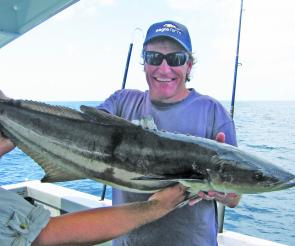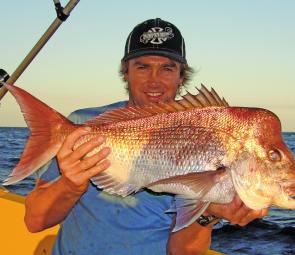As the end of the year and two months of holiday madness looms closer, many locals will put in a big angling effort during November. Angling pressure will increase dramatically and very quickly from early December onwards, so this month is a fantastic time to hit the water.
The summer species are well and truly active by this time of year. My nemesis, the evil dog tooth bream will be terrorizing unwary anglers by way of grab-and-run tactics and hiding in dark, gloomy hideouts. Also known as mangrove jack, these brutish fish will take lure, fly, fresh and live baits and they are widespread throughout the system.
A known structure dweller, these fiery red fish rarely venture far from their chosen lair during the day. As darkness sets in, jacks will head out to hunt and will often wait in ambush to smash careless baitfish that swim too close. So, working out where to place your offering is critical in terms of success.
Blind casting into mid water will rarely bring results. Blind trolling over featureless territory will be just as unsuccessful. Structure means mangrove roots, fallen trees, bridge pylons, rocks wall and rock bars. Fish these areas when there is some movement in the water, particularly dawn or dusk and your chances of tangling with a toothy jack will increase dramatically.
I like positively buoyant bibbed minnows and will always tie one on before selecting a soft plastic. These lures can be worked deep into the structure and allowed to slowly float up through the water column. Tiny twitches here and there may induce an attack from a jack, so hang on tight and be ready for battle.
Jacks will often belt a lure on the turn. So, by the time you register that your lure has taken a belt the jack is already heading back to its oyster encrusted hidey hole. Unfortunately this often results in frayed leaders and frayed nerves! So your choice of terminal tackle and leader needs to be adequate, but not too heavy.
Drifting a live bait into likely structure is another great way to tempt jacks. Some bait fishers prefer a smelly tarpon fillet to attract hem. I have not tried this bait and probably wont bother, but apparently the smell and oily nature of the flesh is undeniably attractive to mangrove jacks and doubtlessly other species as well.
Flathead will be all through the Noosa River and the run-out tide is the best time to target them. Trolling and drifting with live baits or pilchards and casting plastics into likely flathead haunts will deliver the goods.
Bouncing a big plastic along the bottom, particularly adjacent to weed beds or drop-offs will bring strikes from big flatties. Summer is their spawning time so keep a few smaller specimens for the family chef and release any of the larger henfish that you might encounter to continue making babies.
Offshore there are opportunities galore. When the wind and seas allow the closer in reefs are all very much worth a visit. Little Halls Reef is very close to the infamous bar and it can deliver excellent sweetlip, particularly after rain.
The vast North Reef generally yields quality cobia and jew during November, especially for those that use live baits. Sunshine is a good bet for snapper, sweetlip and the delectable coral trout whilst further offshore the Barwon Banks and the Hards will deliver snapper, pearl perch, Moses perch, a few red emperor and mahi mahi.
The reefs up at Double Island Point are worth the run up the coast, or you could even tow the boat up to Tin Can Bay ‑ but you would then need to negotiate the Wide Bay Bar, which makes our version at the mouth of the Noosa River look very tame indeed. This area produces all manner of reef fish as well as the possibility of a few early mackerel, mahi mahi and cobia.
Reads: 2379
A big cobia caught aboard local charter boat Trekka 3.

How's this for a monster knobby? This one took a floating pilchard out at North Reef.

The business end of a toothy jack.

This is local non-stop angler Ben Nothling with a quality snapper from an area wide of Noosa known as 'The Muds'.




